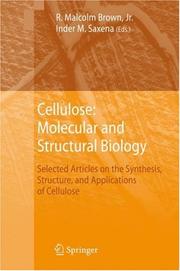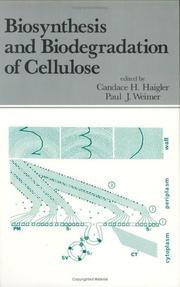| Listing 1 - 5 of 5 |
Sort by
|

ISBN: 9781402053320 9781402053801 1402053320 9048173442 9786610816781 1402053800 1280816783 Year: 2007 Publisher: Dordrecht Springer
Abstract | Keywords | Export | Availability | Bookmark
 Loading...
Loading...Choose an application
- Reference Manager
- EndNote
- RefWorks (Direct export to RefWorks)
Cellulose: Molecular and Structural Biology is an up-to-date treatise on the most advanced and provocative research into the biosynthesis, structure, and applications of nature's most abundant macromolecule and renewable resource, cellulose. Molecular, biochemical, and evolutionary aspects of cellulose biosynthesis are reviewed in a variety of living organisms, including cyanobacteria, eubacteria, (Acetobacter, Salmonella, and E. coli), vascular plants (including Arabidopsis, forest trees, and maize), and tunicates. Phylogenetic analysis, molecular genetics, and the potential for metabolic engineering are also presented. Novel structural approaches include the macromolecular structure of the synthesizing units, the terminal complexes as well as the cellulose product in its many forms are also included. Novel applications using cellulose include smart materials, carbonised cellulose, and biomedical applications. First hand information from the leading researchers distinguishes this work from other books on cellulose.
Cellulose --- Chemistry --- Synthesis --- Cellulose - Chemistry --- Cellulose - Synthesis

ISBN: 0824783875 Year: 1991 Publisher: New York Basel Hong Ko;g Dekker
Abstract | Keywords | Export | Availability | Bookmark
 Loading...
Loading...Choose an application
- Reference Manager
- EndNote
- RefWorks (Direct export to RefWorks)
Microbial metabolism --- Cellulose - Biodegradation. --- Cellulose - Synthesis. --- Microbial metabolism.
Book
Year: 2021 Publisher: Basel, Switzerland MDPI - Multidisciplinary Digital Publishing Institute
Abstract | Keywords | Export | Availability | Bookmark
 Loading...
Loading...Choose an application
- Reference Manager
- EndNote
- RefWorks (Direct export to RefWorks)
Essential oils extracted by the distillation or hydrodistillation of aromatic plants are a complex mixture of volatile compounds with several biological activities. Their efficacy as antimicrobial agents is related to the activity of several natural compounds belonging to different chemical families that can act both in synergy with each other and with other antibiotics. The antibiotic resistance detected among pathogens has been quickly increasing in recent years, and the control of some of these microorganisms is becoming a planetary emergency for human and animal health. The control of the microbial growth is a problem of great importance also for the food industry (food deterioration and shelf life extension) and for the world of cultural heritage (indoor and outdoor phenomena of biodeterioration). Essential oils can play an important role in this scenario, due their recognized broad-spectrum antimicrobial activity. Therefore, the main subject of this Special Issue includes an essential oil-based approach to control microrganisms in areas such as human and veterinary medicine, entomology, food industry and agriculture. In addition, the chemical composition of essential oils from endemic and rare medicinal/aromatic plants, nanoformulations of essential oils, applications in human and veterinary medicine and its use as animal feeding supplements are topics covered in this Special Issue
Technology: general issues --- extracellular polymeric substance matrix --- cellulose synthesis --- enzyme inhibition --- essential oils --- Boswellia sacra --- frankincense essential oil --- GC/MS analysis --- antimicrobial activity --- Staphylococcus aureus --- Pseudomonas aeruginosa --- Propionibacterium acnes --- Candida albicans --- Malassezia furfur --- lamb --- carvacrol --- monensin --- meat tenderness --- TBARS --- essential oil --- genetic --- RAPD --- thyme --- Thymus quinquecostatus --- Thymus vulgaris --- Penicillium rubens --- growth inhibition --- RNA microarray --- gene expression --- metabolic pathway analysis --- Ferula --- GC --- chemometrics --- antioxidant activity --- Acinetobacter baumannii --- MDR --- biofilm --- antimicrobial --- Pimenta --- Myrtaceae --- wound infection --- eugenol --- 1,8-cineole --- GC/MS --- Salmonella --- Origanum vulgare --- ciprofloxacin --- poultry farms --- pig farms --- Staphylococcus spp. --- human semen --- antimicrobial resistance --- rosewood --- linalool --- marine bacteria --- ABTS --- Trypanosoma cruzi --- cytotoxicity --- nitrite --- nitric oxide --- antifungal activity --- nanoencapsulation --- poly(ε-caprolactone) --- Thymus capitatus --- Satureja montana --- Lavandula angustifolia --- Lavandula intermedia --- Origanum hirtum --- Monarda didyma --- Monarda fistulosa --- Alternaria alternata --- cucurbits --- Cymbopogon citratus --- GC-MS --- Stagonosporopsis cucurbitacearum --- n/a
Book
Year: 2021 Publisher: Basel, Switzerland MDPI - Multidisciplinary Digital Publishing Institute
Abstract | Keywords | Export | Availability | Bookmark
 Loading...
Loading...Choose an application
- Reference Manager
- EndNote
- RefWorks (Direct export to RefWorks)
Essential oils extracted by the distillation or hydrodistillation of aromatic plants are a complex mixture of volatile compounds with several biological activities. Their efficacy as antimicrobial agents is related to the activity of several natural compounds belonging to different chemical families that can act both in synergy with each other and with other antibiotics. The antibiotic resistance detected among pathogens has been quickly increasing in recent years, and the control of some of these microorganisms is becoming a planetary emergency for human and animal health. The control of the microbial growth is a problem of great importance also for the food industry (food deterioration and shelf life extension) and for the world of cultural heritage (indoor and outdoor phenomena of biodeterioration). Essential oils can play an important role in this scenario, due their recognized broad-spectrum antimicrobial activity. Therefore, the main subject of this Special Issue includes an essential oil-based approach to control microrganisms in areas such as human and veterinary medicine, entomology, food industry and agriculture. In addition, the chemical composition of essential oils from endemic and rare medicinal/aromatic plants, nanoformulations of essential oils, applications in human and veterinary medicine and its use as animal feeding supplements are topics covered in this Special Issue
extracellular polymeric substance matrix --- cellulose synthesis --- enzyme inhibition --- essential oils --- Boswellia sacra --- frankincense essential oil --- GC/MS analysis --- antimicrobial activity --- Staphylococcus aureus --- Pseudomonas aeruginosa --- Propionibacterium acnes --- Candida albicans --- Malassezia furfur --- lamb --- carvacrol --- monensin --- meat tenderness --- TBARS --- essential oil --- genetic --- RAPD --- thyme --- Thymus quinquecostatus --- Thymus vulgaris --- Penicillium rubens --- growth inhibition --- RNA microarray --- gene expression --- metabolic pathway analysis --- Ferula --- GC --- chemometrics --- antioxidant activity --- Acinetobacter baumannii --- MDR --- biofilm --- antimicrobial --- Pimenta --- Myrtaceae --- wound infection --- eugenol --- 1,8-cineole --- GC/MS --- Salmonella --- Origanum vulgare --- ciprofloxacin --- poultry farms --- pig farms --- Staphylococcus spp. --- human semen --- antimicrobial resistance --- rosewood --- linalool --- marine bacteria --- ABTS --- Trypanosoma cruzi --- cytotoxicity --- nitrite --- nitric oxide --- antifungal activity --- nanoencapsulation --- poly(ε-caprolactone) --- Thymus capitatus --- Satureja montana --- Lavandula angustifolia --- Lavandula intermedia --- Origanum hirtum --- Monarda didyma --- Monarda fistulosa --- Alternaria alternata --- cucurbits --- Cymbopogon citratus --- GC-MS --- Stagonosporopsis cucurbitacearum --- n/a
Book
Year: 2021 Publisher: Basel, Switzerland MDPI - Multidisciplinary Digital Publishing Institute
Abstract | Keywords | Export | Availability | Bookmark
 Loading...
Loading...Choose an application
- Reference Manager
- EndNote
- RefWorks (Direct export to RefWorks)
Essential oils extracted by the distillation or hydrodistillation of aromatic plants are a complex mixture of volatile compounds with several biological activities. Their efficacy as antimicrobial agents is related to the activity of several natural compounds belonging to different chemical families that can act both in synergy with each other and with other antibiotics. The antibiotic resistance detected among pathogens has been quickly increasing in recent years, and the control of some of these microorganisms is becoming a planetary emergency for human and animal health. The control of the microbial growth is a problem of great importance also for the food industry (food deterioration and shelf life extension) and for the world of cultural heritage (indoor and outdoor phenomena of biodeterioration). Essential oils can play an important role in this scenario, due their recognized broad-spectrum antimicrobial activity. Therefore, the main subject of this Special Issue includes an essential oil-based approach to control microrganisms in areas such as human and veterinary medicine, entomology, food industry and agriculture. In addition, the chemical composition of essential oils from endemic and rare medicinal/aromatic plants, nanoformulations of essential oils, applications in human and veterinary medicine and its use as animal feeding supplements are topics covered in this Special Issue
Technology: general issues --- extracellular polymeric substance matrix --- cellulose synthesis --- enzyme inhibition --- essential oils --- Boswellia sacra --- frankincense essential oil --- GC/MS analysis --- antimicrobial activity --- Staphylococcus aureus --- Pseudomonas aeruginosa --- Propionibacterium acnes --- Candida albicans --- Malassezia furfur --- lamb --- carvacrol --- monensin --- meat tenderness --- TBARS --- essential oil --- genetic --- RAPD --- thyme --- Thymus quinquecostatus --- Thymus vulgaris --- Penicillium rubens --- growth inhibition --- RNA microarray --- gene expression --- metabolic pathway analysis --- Ferula --- GC --- chemometrics --- antioxidant activity --- Acinetobacter baumannii --- MDR --- biofilm --- antimicrobial --- Pimenta --- Myrtaceae --- wound infection --- eugenol --- 1,8-cineole --- GC/MS --- Salmonella --- Origanum vulgare --- ciprofloxacin --- poultry farms --- pig farms --- Staphylococcus spp. --- human semen --- antimicrobial resistance --- rosewood --- linalool --- marine bacteria --- ABTS --- Trypanosoma cruzi --- cytotoxicity --- nitrite --- nitric oxide --- antifungal activity --- nanoencapsulation --- poly(ε-caprolactone) --- Thymus capitatus --- Satureja montana --- Lavandula angustifolia --- Lavandula intermedia --- Origanum hirtum --- Monarda didyma --- Monarda fistulosa --- Alternaria alternata --- cucurbits --- Cymbopogon citratus --- GC-MS --- Stagonosporopsis cucurbitacearum --- extracellular polymeric substance matrix --- cellulose synthesis --- enzyme inhibition --- essential oils --- Boswellia sacra --- frankincense essential oil --- GC/MS analysis --- antimicrobial activity --- Staphylococcus aureus --- Pseudomonas aeruginosa --- Propionibacterium acnes --- Candida albicans --- Malassezia furfur --- lamb --- carvacrol --- monensin --- meat tenderness --- TBARS --- essential oil --- genetic --- RAPD --- thyme --- Thymus quinquecostatus --- Thymus vulgaris --- Penicillium rubens --- growth inhibition --- RNA microarray --- gene expression --- metabolic pathway analysis --- Ferula --- GC --- chemometrics --- antioxidant activity --- Acinetobacter baumannii --- MDR --- biofilm --- antimicrobial --- Pimenta --- Myrtaceae --- wound infection --- eugenol --- 1,8-cineole --- GC/MS --- Salmonella --- Origanum vulgare --- ciprofloxacin --- poultry farms --- pig farms --- Staphylococcus spp. --- human semen --- antimicrobial resistance --- rosewood --- linalool --- marine bacteria --- ABTS --- Trypanosoma cruzi --- cytotoxicity --- nitrite --- nitric oxide --- antifungal activity --- nanoencapsulation --- poly(ε-caprolactone) --- Thymus capitatus --- Satureja montana --- Lavandula angustifolia --- Lavandula intermedia --- Origanum hirtum --- Monarda didyma --- Monarda fistulosa --- Alternaria alternata --- cucurbits --- Cymbopogon citratus --- GC-MS --- Stagonosporopsis cucurbitacearum
| Listing 1 - 5 of 5 |
Sort by
|

 Search
Search Feedback
Feedback About UniCat
About UniCat  Help
Help News
News